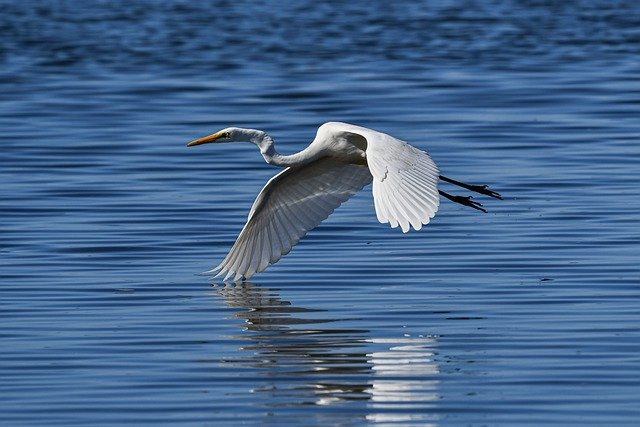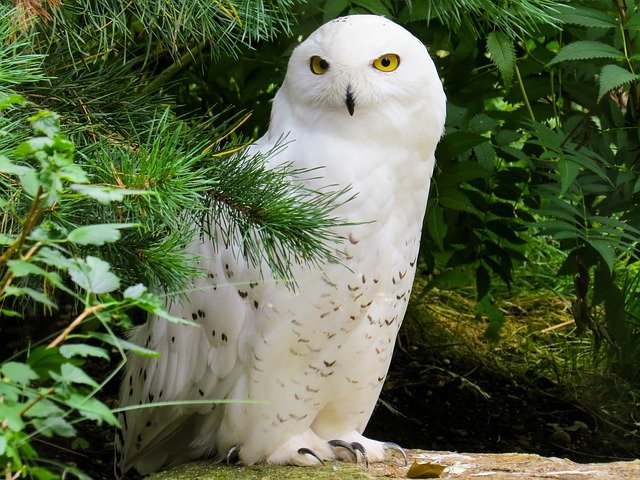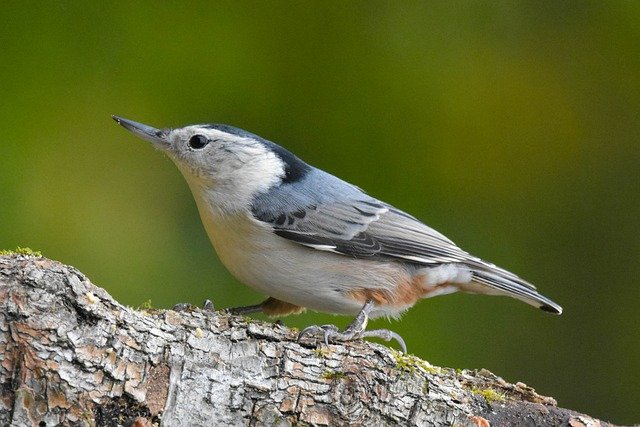In this article I’ll be going over 5 white birds that can be found across the state of North Dakota so continue reading for a more detailed look at each bird below.
- Great Egret
- Snowy Owl
- White Breasted Nuthatch
- American Herring Gull
- American White Pelican
5 White Birds In North Dakota
1. Great Egret (Ardea Alba)

- Size: 80 – 100cm
- Weight: 0.7 – 1.5kg
- Wingspan: 130 – 170cm
You’ll be able to spot great egrets in central and the eastern regions of North Dakota when migrating.
Great egrets are recognised by their extremely long necks, yellow bill, long black legs and mostly white plumage. Both males and females look very similar with the males being generally larger than the females.
Great egrets spend the majority of their time within marshes, ponds, shores and mud flats.
As for what they eat, it includes primarily consume fish along with crustaceans, amphibians, and small mammals. They will also forage around open areas.
Great egrets tend to live for around 15 years in the wild and around 22 years in captivity.
2. Snowy Owl (Bubo Scandiacus)

- Size: 52 – 71cm
- Weight: 1.1 – 2kg
- Wingspan: 125 – 164cm
Snowy owls can be found all throughout North Dakota in their non-breeding fall and winter months.
These owls are recognised by their mostly white plumage with brown dots throughout the body. Females on the other hand are generally less white than the males as the brown spots encompass more of their body.
Snowy owls tend to spend their time within arctic tundra or open grasslands and fields, whilst avoiding forested areas.
As for what they eat, it includes lemmings and a variety of small mammals. Nevertheless, they will still occasionally eat larger mammals like like hares, rats, rabbits, etc.
Snowy owls have been observed to live for around 28 years in captivity and between 10+ years in the wild.
3. White Breasted Nuthatch (Sitta Carolinensis)

- Size: 13 – 14cm
- Weight: 18 – 30 grams
- Wingspan: 20 – 27cm
White breasted nuthatches can be found in all of North Dakota throughout the year.
These white breasted nuthatches are recognised by their gray back, wings and the upper head with white breast feathers. Females look the same as the males.
As for where you would find these white breasted nuthatches, it would be around mature woods and woodland edges, where they’re most commonly located by deciduous stands that have maple, hickory, basswood, oak and are even found in some coniferous forests.
They mostly consume nuts, seeds and insects, which can include hazelnuts, sunflower seeds and suet.
As for how long white breasted nuthatches live in the wild, it tends to be around 2 years with the longest lifespan recorded around 12 years.
4. American Herring Gull (Larus Smithsonianus)

- Size: 60 – 67cm
- Weight: 1 – 1.5kg
- Wingspan: 120 – 160cm
You’ll find American herring gulls all across the state of North Dakota when migrating through the state.
American herring gulls are recognised by their gray wings, black tail feather, white feathers in the remainder of their body, yellow beak and reddish/orange legs. The females are typically a dirty light brown/gray color where it appears as if they’ve had mud sprayed across their feathers.
You’ll find these herring gulls around coasts and inland around rubbish tips, fields, large reservoirs and lakes.
In regards to what these gulls eat, it tends to be carrion, offal, seeds, fruits, young birds, eggs, small mammals, insects and fish.
American herring gulls are know to live for around 30 years on average, with the longest recorded hitting 49 years of age.
5. American White Pelican (Pelecanus Erythrorhynchos)

- Size: 130 – 160cm
- Weight: 6 – 6.5kg
- Wingspan: 260 – 290cm
American white pelicans will use the eastern regions of North Dakota when breeding and the remainder of the state when they migrate.
These pelicans can be recognised by their mostly white plumage and extremely large bills. Females look vey similar to the males.
You’ll often spot these birds around lakes and rivers.
As for what they eat, it includes mostly fish of the rough kind that humans don’t typically capture, smaller amphibians and crayfish.
Wild American white pelicans are known to live for around 16 year in the wild whilst captive ones are known to be around the 30 – 35 year range.
Amhil Khan, a dedicated nature enthusiast and the founder of BirdsOfTheWild.com, is a passionate advocate for the captivating world of avian wonders. With a deep-seated curiosity about the intricate lives of birds, Amhil’s journey began as a fascination and has evolved into a mission to inspire others to appreciate and protect these magnificent creatures.
Amhil’s love for birds led to the creation of Birds of the Wild, a platform where his expertise in ornithology, coupled with his captivating storytelling, provides readers with an immersive and educational experience. Through his lens and words, he captures the essence of birds in their natural habitats, offering a glimpse into their behaviors, migrations, and the ecosystems they inhabit.

